Minimum Dietary Diversity Scores for Women Indicate Micronutrient Adequacy and Food Insecurity Status in South African Towns
Abstract
:1. Introduction
- Minimum Dietary Diversity for WRA (MDD-W) decreases with a decrease in agro-ecological potential.
- Peri-urban women would report higher levels of food insecurity than those in more rural and urbanised areas.
- Monotonous diets would be observed for women from poor households and these will be based mainly on starchy staples, with little vegetables and fruit.
- The MDD-W and food security would be associated with household size, wealth, and food expenditure.
2. Materials and Methods
2.1. Study Sites
2.2. Sampling
2.3. Minimum Dietary Diversity for WRA (MDD-W)
2.4. Statistical Analysis
3. Results
3.1. Household Characteristics
3.2. Dietary Diversity
3.3. Differences in MDD-W between and within Towns
3.4. Association of MDD-W with Socio-Economic Indicators
4. Discussion
5. Conclusions
Acknowledgments
Author Contributions
Conflicts of Interest
References
- Godfray, H.C.J.; Beddington, J.R.; Crute, I.R.; Haddad, L.; Lawrence, D.; Muir, J.F.; Toulmin, C. Food security: The challenge of feeding 9 billion people. Science 2010, 327, 812–818. [Google Scholar] [CrossRef] [PubMed]
- Food and Agriculture Organisation (FAO); World Food Programme (WFP); International Fund for Agricultural Development (IFAD). The State of Food Insecurity in the World 2015. Meeting the 2015 International Hunger Targets: Taking Stock of Uneven Progress; Food and Agriculture Organisation of the United Nations: Rome, Italy, 2015; Available online: http://www.fao.org/3/a-i4646e.pdf (accessed on 14 August 2015).
- Food and Agriculture Organisation (FAO); World Food Programme (WFP); International Fund for Agricultural Development (IFAD). The State of Food Insecurity in the World: Economic Growth Is Necessary but Not Sufficient to Accelerate Reduction of Hunger and Malnutrition; Food and Agriculture Organisation: Rome, Italy, 2012; Available online: http://www.fao.org/docrep/016/i3027e/i3027e.pdf (accessed on 25 June 2014).
- Harris-Fry, H.; Azad, K.; Kuddus, A.; Shaha, S.; Nahar, B.; Hossen, M.; Younes, L.; Costello, A.; Fottrell, E. Socio-economic determinants of household food security and women’s dietary diversity in rural Bangladesh: A cross-sectional study. J. Health Popul. Nutr. 2015, 33, 1–12. [Google Scholar] [CrossRef] [PubMed]
- United Nations (UN). The Millennium Development Goals Report; United Nations: New York, NY, USA, 2008; Available online: http://www.un.org/millenniumgoals/2008highlevel/pdf/newsroom/mdg%20reports/MDG_Report_2008_ENGLISH.pdf (accessed on 25 June 2014).
- Ingram, J.; Ericksen, P.; Liverman, D. Food Security and Global Environmental Change; Ingram, J.S.I., Ericksen, P., Liverman, D., Eds.; Earthscan: London, UK, 2010. [Google Scholar]
- Poppy, G.M.; Jepson, P.C.; Pickett, J.A.; Birkett, M.A. Achieving food and environmental security: New approaches to close the gap. Philos. Trans. R. Soc. Lond. B Biol. Sci. 2014, 369, 20120272. [Google Scholar] [CrossRef] [PubMed]
- International Food Policy Research Institute (IFPRI). 2014–2015 Global Food Policy Report; International Food Policy Research Institute: Washington, DC, USA, 2015; Available online: http://www.ifpri.org/publication/2014-2015-global-food-policy-report (accessed on 19 April 2016).
- Kennedy, G.L. Evaluation of Dietary Diversity Scores for Assessment of Micronutrient Intake and Food Security in Developing Countries. Ph.D. Thesis, University of Wagenningen, Wageningen, The Netherlands, 2009. [Google Scholar]
- Arimond, M.; Wiesmann, D.; Becquey, E.; Carriquiry, A.; Daniels, M.C.; Deitchler, M.; Fanou-Fogny, N.; Joseph, M.L.; Kennedy, G.; Martin-Prevel, Y.; et al. Simple food group diversity indicators predict micronutrient adequacy of women’s diets in 5 diverse, resource-poor settings. J. Nutr. 2010, 140, 2059S–2069S. [Google Scholar] [CrossRef] [PubMed]
- Food and Agriculture Organisation (FAO). Guidelines for Measuring Household and Individual Dietary Diversity; Food and Agriculture Organisation of the United Nations: Rome, Italy, 2011; Available online: http://www.fao.org/3/a-i1983e.pdf (accessed on 26 June 2014).
- Martin-Prével, Y.; Allemand, P.; Wiesmann, D.; Arimond, M.; Ballard, T.; Deitchler, M.; Dop, M.C.; Kennedy, G.; Lee, W.T.; Mousi, M. Moving Forward on Choosing a Standard Operational Indicator of Women’s Dietary Diversity; Food and Agriculture Organisation of the United Nations: Rome, Italy, 2015; Available online: https://cgspace.cgiar.org/handle/10568/72450 (accessed on 13 April 2017).
- Food and Agriculture Organisation (FAO); FHI 360. Minimum Dietary Diversity for Women: A Guide for Measurement; Food and Agriculture Organisation of the United Nations: Rome, Italy, 2016; Available online: http://www.fao.org/3/a-i5486e.pdf (accessed on 13 April 2017).
- Hoddinott, J.; Yohannes, Y. Dietary Diversity as a Household Food Security Indicator; FANTA Project, Academy for Educational Development: Washington, DC, USA, 2002; Available online: https://www.researchgate.net/profile/John_Hoddinott/publication/5056359_Dietary_Diversity_as_a_Food_Security_Indicator/links/09e4150ab85a53bf74000000.pdf (accessed on 5 May 2014).
- Whitaker, R.C.; Phillips, S.M.; Orzol, S.M. Food insecurity and the risks of depression and anxiety in mothers and behavior problems in their preschool-aged children. Pediatrics 2006, 118, e859–e868. [Google Scholar] [CrossRef] [PubMed]
- Olson, C.M. Food insecurity in women: A recipe for unhealthy trade-offs. Top. Clin. Nutr. 2005, 20, 321–328. [Google Scholar] [CrossRef]
- Hadley, C.; Lindstrom, D.; Tessema, F.; Belachew, T. Gender bias in the food insecurity experience of Ethiopian adolescents. Soc. Sci. Med. 2008, 66, 427–438. [Google Scholar] [CrossRef] [PubMed]
- Sasson, A. Food security for Africa: An urgent global challenge. Agric. Food Secur. 2012, 1, 1–16. [Google Scholar] [CrossRef]
- Allen, L. Multiple micronutrients in pregnancy and lactation: An overview. Am. J. Clin. Nutr. 2005, 81, 1206S–1212S. [Google Scholar] [PubMed]
- Bartley, K.A.; Underwood, B.A.; Deckelbaum, R.J. A life cycle micronutrient perspective for women’s health. Am. J. Clin. Nutr. 2005, 81, 1188S–1193S. [Google Scholar] [PubMed]
- Kuku, O.; Gundersen, C.; Garasky, S. Differences in food insecurity between adults and children in Zimbabwe. Food Policy 2011, 36, 311–317. [Google Scholar] [CrossRef]
- Saaka, M.; Osman, S.M. Does household food insecurity affect the nutritional status of preschool children aged 6–36 months? Int. J. Popul. Res. 2013, 2013, 1–12. [Google Scholar] [CrossRef]
- Drewnowski, A.; Darmon, N. Food choices and diet costs: An economic analysis. J. Nutr. 2005, 135, 900–904. [Google Scholar] [PubMed]
- Faber, M.; Witten, C.; Drimie, S. Community-based agricultural interventions in the context of food and nutrition security in South Africa. S. Afr. J. Clin. Nutr. 2011, 24, 21–30. [Google Scholar] [CrossRef]
- Laraia, B.A.; Siega-Riz, A.M.; Gundersen, C. Household food insecurity is associated with self-reported pregravid weight status, gestational weight gain, and pregnancy complications. J. Am. Diet Assoc. 2010, 110, 692–701. [Google Scholar] [CrossRef] [PubMed]
- Altman, M.; Hart, T.; Jacobs, P. Household food security status in South Africa. Agrekon 2009, 48, 45–361. [Google Scholar] [CrossRef]
- Drimie, S.; McLachlan, M. Food security in South Africa-first steps toward a transdisciplinary approach. Food Secur. 2013, 5, 217–226. [Google Scholar] [CrossRef]
- Statistics South Africa (Stats SA). Poverty Trends in South Africa. An Examination of Absolute Poverty between 2006 and 2011; Report No. 03-10-06; Statistics South Africa: Pretoria, South Africa, 2014. Available online: http://www.statssa.gov.za/?p=2591 (accessed on 10 March 2016).
- Chopra, M.; Daviaud, E.; Pattinson, R.; Fonn, S.; Lawn, J.E. Saving the lives of South Africa’s mothers, babies, and children: Can the health system deliver? Lancet 2009, 374, 835–846. [Google Scholar] [CrossRef]
- Drimie, S.; Ruysenaar, S. The integrated food security strategy of South Africa: An institutional analysis. Agrekon 2010, 49, 316–337. [Google Scholar] [CrossRef]
- Schönfeldt, H.C.; Gibson, N.; Vermeulen, H. The possible impact of inflation on nutritionally vulnerable households in a developing country using South Africa as a case study. Nutr. Bull. 2010, 35, 254–267. [Google Scholar] [CrossRef]
- Drimie, S.; Faber, M.; Vearey, J.; Nunez, L. Dietary diversity of formal and informal residence in Johannesburg, South Africa. BMC Public Health 2013, 13, 911. [Google Scholar] [CrossRef] [PubMed]
- Battersby, J. Urban food insecurity in Cape Town, South Africa: An alternative approach to food access. Dev. S. Afr. 2011, 28, 545–561. [Google Scholar] [CrossRef]
- Hebinck, P.G.M.; Lent, P.C. Livelihoods and Landscapes: The People of Guquka and Koloni and Their Resources; Brill: Leiden, The Netherlands, 2007; Volume 9. [Google Scholar]
- Shackleton, R.; Shackleton, C.; Shackleton, S.; Gambiza, J. Deagrarianisation and forest revegetation in a biodiversity hotspot on the Wild Coast, South Africa. PLoS ONE 2013, 8, e76939. [Google Scholar] [CrossRef] [PubMed]
- Crush, J.; Frayne, B. Urban food insecurity and the new international food security agenda. Dev. S. Afr. 2011, 28, 527–544. [Google Scholar] [CrossRef]
- Musemwa, L.; Muchenje, V.; Mushunje, A.; Aghdasi, F.; Zhou, L. Household food insecurity in the poorest province of South Africa: Level, causes and coping strategies. Food Secur. 2015, 7, 647–655. [Google Scholar] [CrossRef]
- Shisana, O.; Labadarios, D.; Rehle, T.; Simbayi, L.; Zuma, K.; Dhansay, A.; Reddy, P.; Parker, W.; Hoosain, E.; Naidoo, P.; et al. South African National Health and Nutrition Examination Survey (SANHANES-1); HSRC Press: Cape Town, South Africa, 2013; Available online: http://www.hsrc.ac.za/uploads/pageNews/72/SANHANES-launch%20edition%20(online%20version).pdf (accessed on 20 August 2014).
- HarvestChoice. Agro-Ecological Zones of Sub-Saharan Africa; International Food Policy Research Institute: Washington, DC, USA; University of Minnesota: Minneapolis, MN, USA, 2010; Available online: https://harvestchoice.org/maps/agro-ecological-zones-sub-saharan-africa (accessed on 16 November 2015).
- Arimond, M.; Wiesmann, D.; Becquey, E.; Carriquiry, A.; Daniels, M.; Deitchler, M.; Fanou, N.; Ferguson, E.; Joseph, M.; Kennedy, G.; et al. Dietary Diversity as a Measure of the Micronutrient Adequacy of Women’s Diets in Resource-Poor Areas: Summary of Results from Five Sites; FANTA II Project: Washington, DC, USA, 2011; Available online: https://www.fantaproject.org/sites/default/files/resources/WDDP_Summary_Report_Jul2011.pdf (accessed on 22 May 2014).
- Oldewage-Theron, W.H.; Kruger, R. Food variety and dietary diversity as indicators of the dietary adequacy and health status of an elderly population in Sharpeville, South Africa. J. Nutr. Elder. 2008, 27, 101–133. [Google Scholar] [CrossRef] [PubMed]
- Acham, H.; Oldewage-Theron, W.H.; Egal, A.A. Dietary diversity, micronutrient intake and their variation among black women in informal settlements in South Africa: A cross-sectional study. Int. J. Nutr. Metab. 2012, 4, 24–39. [Google Scholar]
- Labadarios, D.; Mchiza, Z.J.L.; Steyn, N.P.; Gerike, G.; Mounder, E.M.W.; Davids, Y.D.; Parker, W. Food security in South Africa: A review of national surveys. Bull. World Health Organ. 2011, 89, 891–899. [Google Scholar] [CrossRef] [PubMed]
- Brinkman, H.J.; de Pee, S.; Sanogo, I.; Subran, L.; Bloem, M.W. High food prices and the global financial crisis have reduced access to nutritious food and worsened nutritiona status and health. J. Nutr. 2010, 140, 153S–161S. [Google Scholar] [CrossRef] [PubMed]
- Oldewage-Theron, W.H.; Dicks, E.G.; Napier, C.E. Poverty, household food insecurity and nutrition: Coping strategies in an informal settlement in the Vaal Triangle, South Africa. Public Health 2010, 120, 795–804. [Google Scholar] [CrossRef] [PubMed]
- Modi, M.; Modi, A.T.; Hendriks, S. Potential role for wild vegetables in household food security: A preliminary case study in Kwazulu-Natal, South Africa. Afr. J. Food Agric. Nutr. Dev. 2006, 6, 1–13. [Google Scholar] [CrossRef]
- Mkwambisi, D.D.; Fraser, E.D.; Dougill, A.J. Urban agriculture and poverty reduction: Evaluating how food production in cities contributes to food security, employment and income in Malawi. J. Int. Dev. 2011, 23, 181–203. [Google Scholar] [CrossRef]
- Zezza, A.; Tasciotti, L. Urban agriculture, poverty, and food security: Empirical evidence from a sample of developing countries. Food Policy 2010, 35, 265–273. [Google Scholar] [CrossRef]
- Baiphethi, M.N.; Jacobs, P.T. The contribution of subsistence farming to food security in South Africa. Agrekon 2009, 48, 459–482. [Google Scholar] [CrossRef]
- Crush, J.; Hovorka, A.; Tevera, D. Food security in southern African cities: The place of urban agriculture. Prog. Dev. Stud. 2011, 11, 285–305. [Google Scholar] [CrossRef]
- Mojeremane, W.; Tshwenyane, S.O. Azanza garckeana: A valuable indigenous fruit tree of Botswana. Pak. J. Nutr. 2004, 3, 264–267. [Google Scholar]
- Jumbe, C.B.L.; Bwalya, S.M.; Husselman, M. Contribution of Dry Forests to Rural Livelihoods and the National Economy in Zambia; Centre for International Forestry Research: Lusaka, Zambia, 2008; Available online: http://www.cifor.org/miombo/docs/ZambiaNationalCaseStudy.pdf (accessed on 9 September 2015).
- Arnold, M.; Powell, B.; Shanley, P.; Sunderland, T.C.H. Forests, biodiversity and food security. Int. For. Rev. 2011, 13, 259–264. [Google Scholar]
- Legwaila, G.M.; Mojeremane, W.; Madisa, M.E.; Mmolotsi, R.M.; Rampart, M. Potential of traditional food plants in rural household food security in Botswana. J. Hortic. For. 2011, 3, 171–177. [Google Scholar]
- Jacobs, P.T. The status of household food security targets in South Africa. Agrekon 2009, 48, 410–433. [Google Scholar] [CrossRef]
- Rudolph, M.; Kroll, F.; Ruysenaar, S.; Dlamini, T. The State of Food Insecurity in Johannesburg; Urban Food Security Series No. 12; Queen’s University: Kingston, ON, Canada; AFSUN: Cape Town, South Africa, 2013; Available online: http://www.afsun.org/wp-content/uploads/2013/09/AFSUN_12.pdf (accessed on 17 February 2016).
- Naicker, N.; Mathee, A.; Teare, J. Food insecurity in households in informal settlements in urban South Africa. S. Afr. Med. J. 2015, 105, 268–270. [Google Scholar] [CrossRef] [PubMed]
- Carney, P.A.; Hamada, J.L.; Rdesinski, R.; Sprager, L.; Nichols, K.R.; Liu, B.Y.; Pelayo, J.; Sanchez, M.A.; Shannon, J. Impact of a community gardening project on vegetable intake, food security and family relationships: A community-based participatory research study. J. Community Health 2012, 37, 874–881. [Google Scholar] [CrossRef] [PubMed]
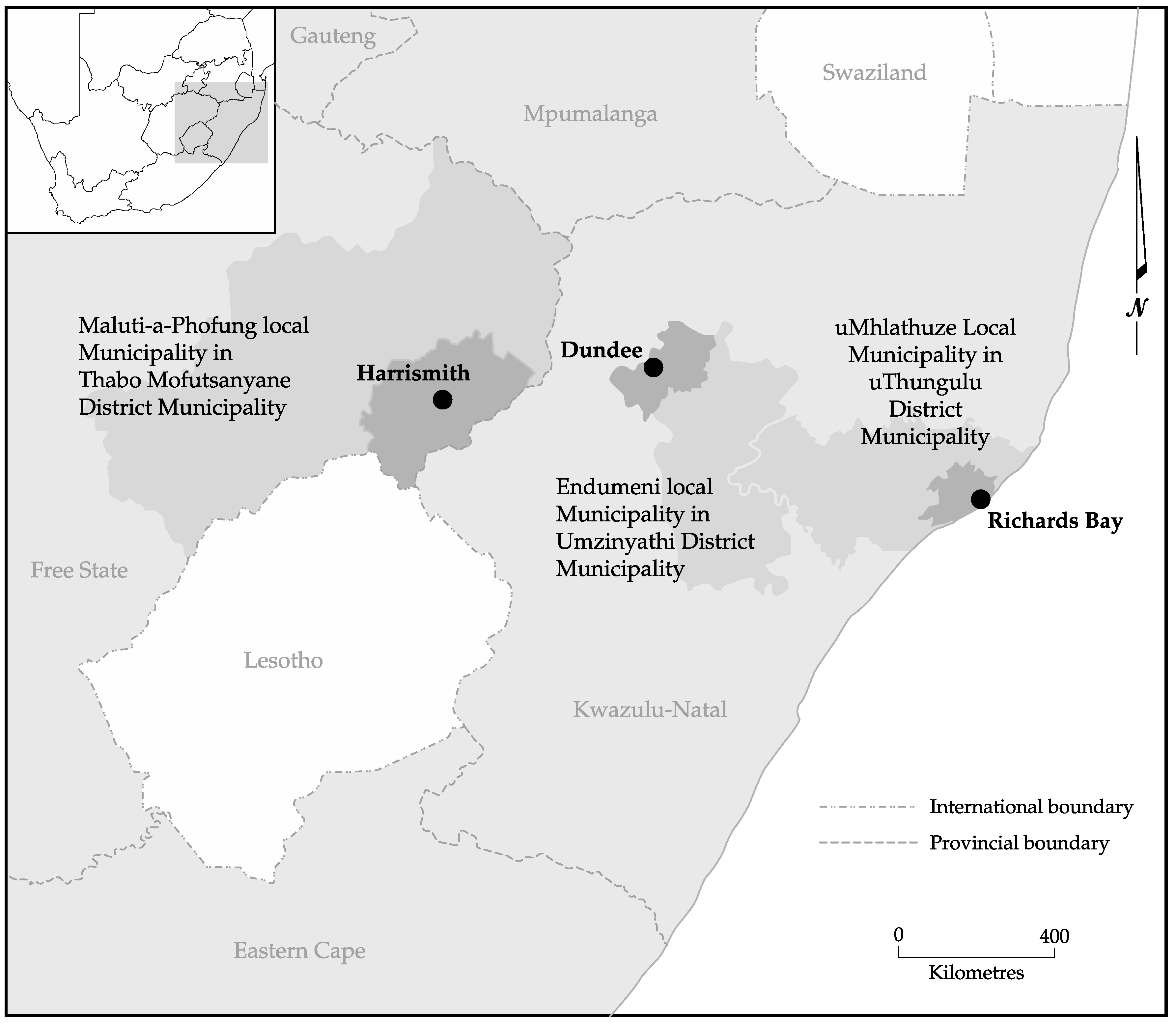
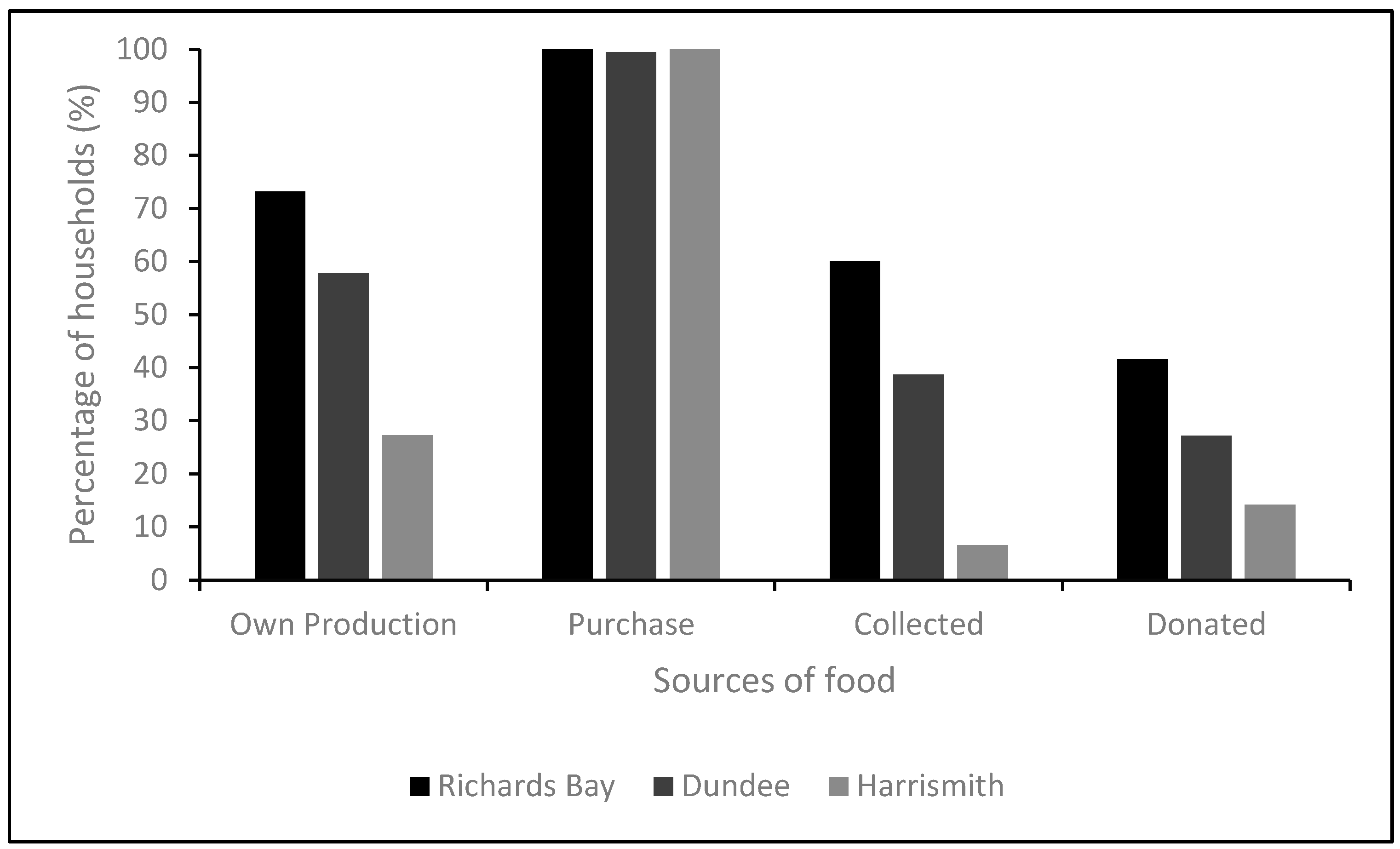
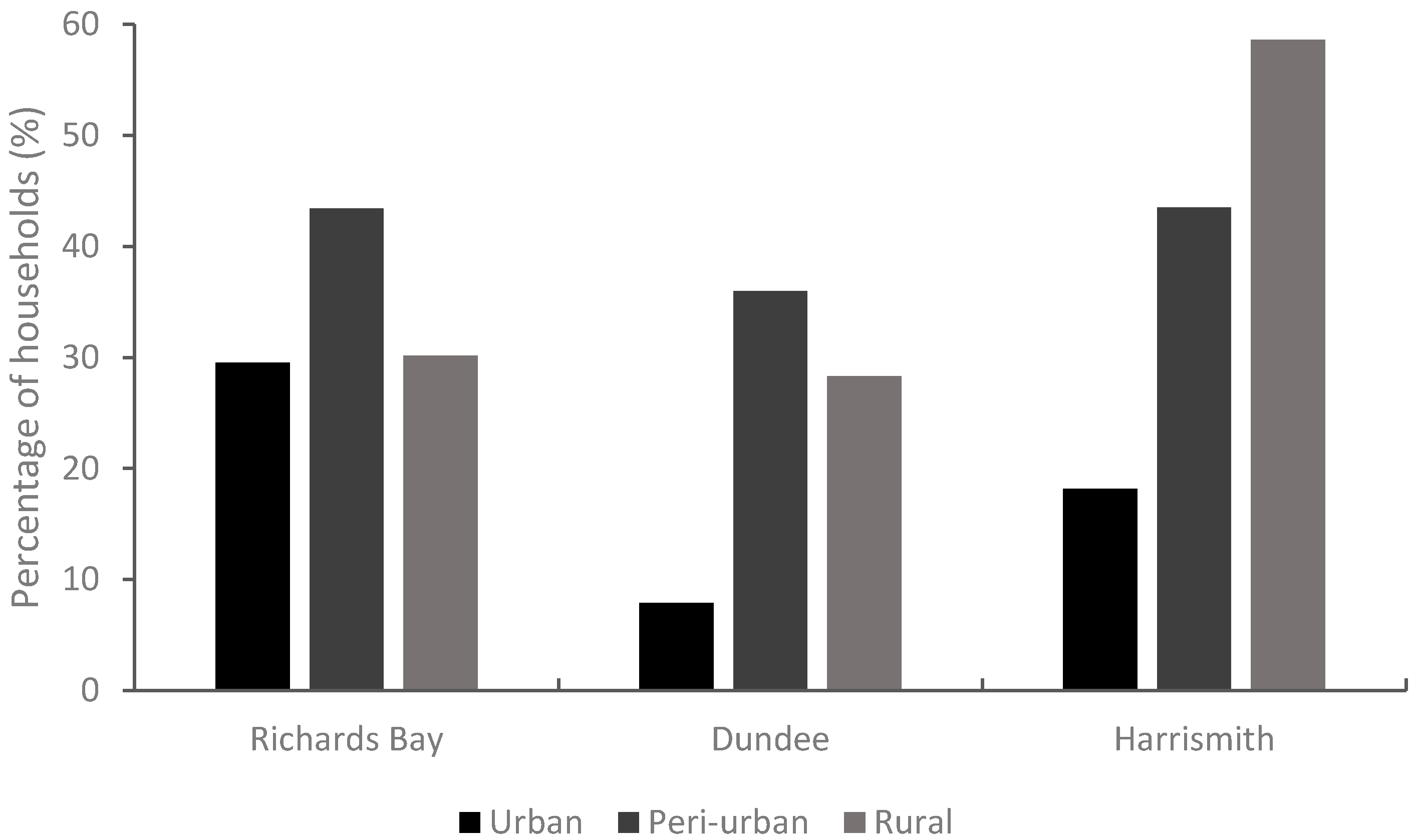
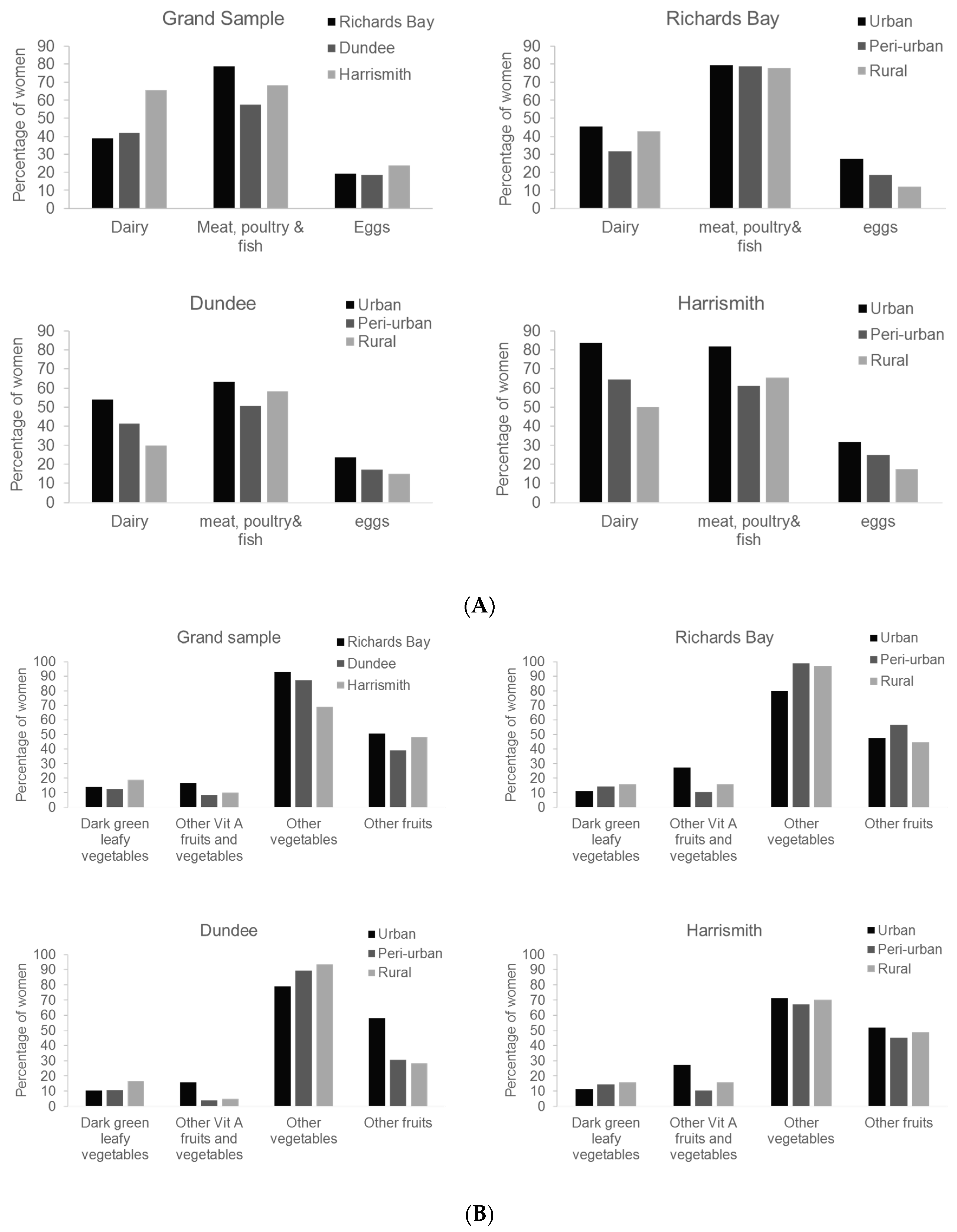
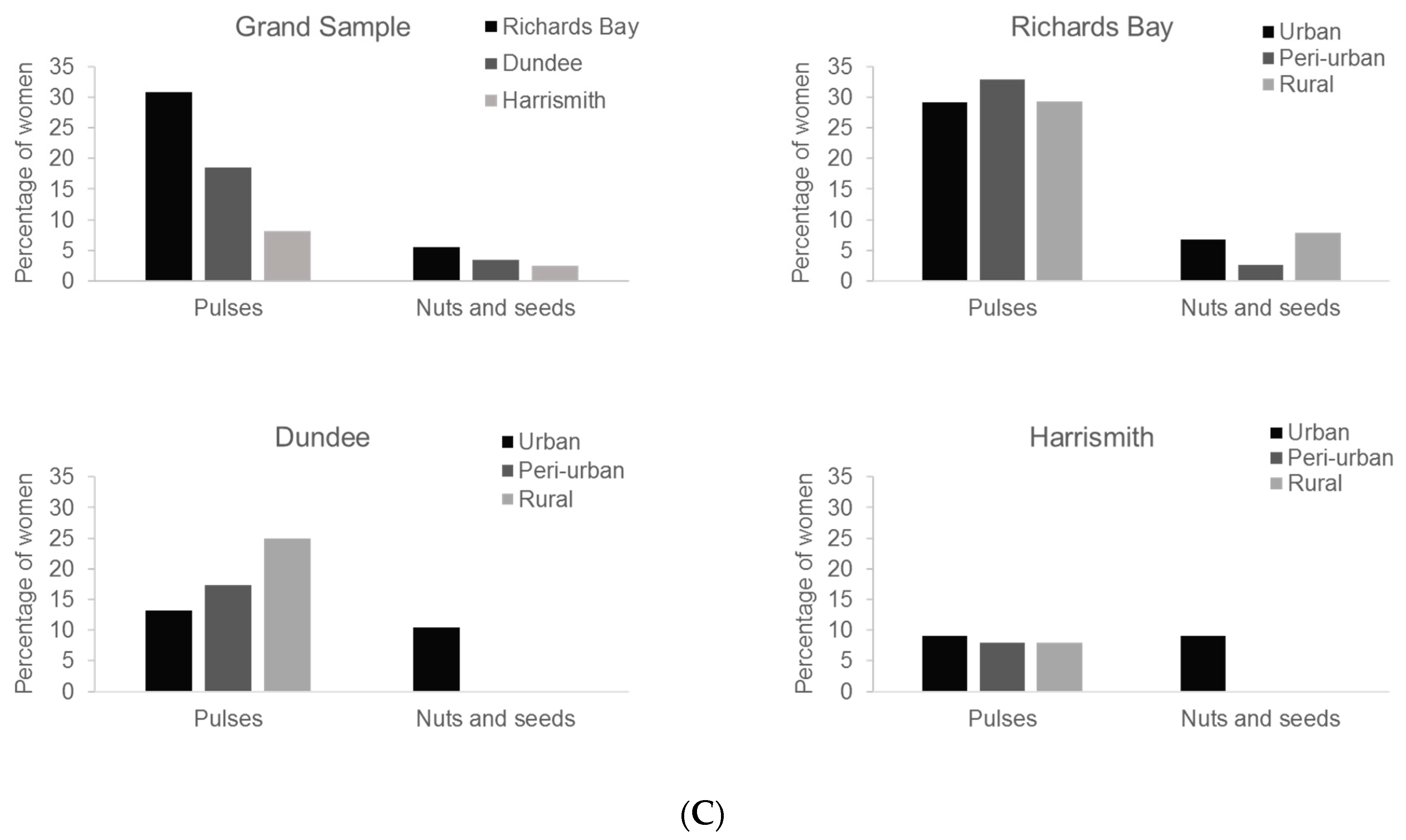
| Variable | Richards Bay (n = 183) | Dundee (n = 173) | Harrismith (n = 198) | All (n = 554) |
|---|---|---|---|---|
| Respondent age (mean ± SD) (year) | 29 ± 9.0 | 33 ± 10.8 | 33 ± 9.9 | 32 ± 10 |
| Household size (mean ± SD) (number of people) | 7 ± 4.6 | 8 ± 4.2 | 6 ± 2.2 | 7 ± 4 |
| Household head (%) | ||||
| Male | 42 | 36 | 47 | 42 |
| Female | 58 | 64 | 53 | 58 |
| Some form of cash income (%) | ||||
| None | 41 | 20 | 9 | 23 |
| One income | 49 | 59 | 72 | 60 |
| Two or more incomes | 10 | 21 | 19 | 17 |
| Food expenditure (mean ± SD) (Rand/week) | 196 ± 180 | 333 ± 253 | 323 ± 271 | 284 ± 246 |
| Wealth index (see methods) | 2.6 ± 0.6 | 2.3 ± 1.0 | 2.5 ± 0.9 | 2.5 ± 0.8 |
| Households with land for own production (%) | 73 | 57 | 27 | 52 |
| Town | MDD-W (Mean ± sd) | Location | MDD-W (Mean ± sd) | Percentage of Women | |
|---|---|---|---|---|---|
| <5 Food Groups | ≥5 Food Groups | ||||
| Richards Bay (n = 183) | 3.78 ± 0.07 a | 66 | 34 | ||
| Urban (n = 44) | 4.79 ± 0.15 a | 68 | 32 | ||
| Peri-Urban (n = 76) | 3.19 ± 0.11 a | 80 | 20 | ||
| Rural (n = 63) | 3.40 ± 0.13 a | 78 | 22 | ||
| Dundee (n = 173) | 3.21 ± 0.08 b | 87 | 13 | ||
| Urban (n = 38) | 3.74 ± 0.16 a | 74 | 26 | ||
| Peri-Urban (n = 75) | 3.09 ± 0.11 b | 91 | 9 | ||
| Rural (n = 60) | 3.03 ± 0.12 a/b | 93 | 7 | ||
| Harrismith (n = 198) | 3.36 ± 0.07 b | 73 | 27 | ||
| Urban (n = 55) | 4.05 ± 0.12 a | 67 | 33 | ||
| Peri-Urban (n = 85) | 3.78 ± 0.10 b | 73 | 27 | ||
| Rural (n = 58) | 3.53 ± 0.12 b | 78 | 22 | ||
| All towns (n = 554) | 3.46 ± 0.99 | 75 | 25 | ||
| Urban (n = 137) | 3.82 ± 0.09 a | 69 | 31 | ||
| Peri-urban (n = 236) | 3.37 ± 0.07 b | 81 | 19 | ||
| Rural (n = 181) | 3.31 ± 0.07 b | 83 | 17 | ||
| Town | Household Size | Food Expenditure per Week | Wealth Index | Access to Land |
|---|---|---|---|---|
| Richards Bay | −0.017 | 0.294 a | 0.333 a | 0.155 b |
| Dundee | −0.063 | 0.286 a | 0.267 a | 0.117 |
| Harrismith | −0.101 | 0.533 a | 0.341 a | 0.031 |
| Town | Location | Food Expenditure per Week | Wealth Index |
|---|---|---|---|
| Richards Bay | Urban | 0.350 a | 0.251 |
| Peri-urban | 0.467 b | 0.429 b | |
| Rural | −0.009 | 0.236 | |
| Dundee | Urban | 0.427 b | 0.156 |
| Peri-urban | 0.127 | 0.132 | |
| Rural | 0.243 | 0.338 b | |
| Harrismith | Urban | 0.099 | −0.011 |
| Peri-urban | 0.549 c | 0.295 b | |
| Rural | 0.468 c | 0.422 b |
© 2017 by the authors. Licensee MDPI, Basel, Switzerland. This article is an open access article distributed under the terms and conditions of the Creative Commons Attribution (CC BY) license (http://creativecommons.org/licenses/by/4.0/).
Share and Cite
Chakona, G.; Shackleton, C. Minimum Dietary Diversity Scores for Women Indicate Micronutrient Adequacy and Food Insecurity Status in South African Towns. Nutrients 2017, 9, 812. https://doi.org/10.3390/nu9080812
Chakona G, Shackleton C. Minimum Dietary Diversity Scores for Women Indicate Micronutrient Adequacy and Food Insecurity Status in South African Towns. Nutrients. 2017; 9(8):812. https://doi.org/10.3390/nu9080812
Chicago/Turabian StyleChakona, Gamuchirai, and Charlie Shackleton. 2017. "Minimum Dietary Diversity Scores for Women Indicate Micronutrient Adequacy and Food Insecurity Status in South African Towns" Nutrients 9, no. 8: 812. https://doi.org/10.3390/nu9080812
APA StyleChakona, G., & Shackleton, C. (2017). Minimum Dietary Diversity Scores for Women Indicate Micronutrient Adequacy and Food Insecurity Status in South African Towns. Nutrients, 9(8), 812. https://doi.org/10.3390/nu9080812






